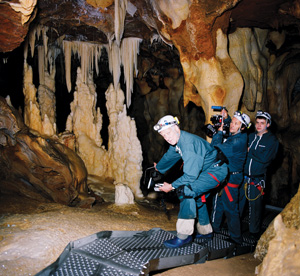DESPITE the deaths of Welles and Heston, cinematic narration muddles along somehow. We do have the molasses-drenched tonsils of Morgan Freeman, still the voice of Jehovah’s own unequivocation, and we have F. Murray Abraham finding the slightly droll side of jungle animals disemboweling each other on Nature documentaries.
But there’s nothing that says angst like director Werner Herzog describing what we’re seeing. In his 3-D film Cave of Forgotten Dreams, he’s busy: the unnerved, emotionally affecting tones (you can imagine him saying “And I only am escaped alone to tell thee”) might be the words of the last man on Earth.
Herzog goes underground in Cave of Forgotten Dreams to Chauvet-Pont D’Arc in the Ardeche region of France. This trove contains the oldest known prehistoric art, 30,000 years old, sealed off from the world for most of that time. The caves were discovered in 1994, and since then only a few visitors have been allowed inside on a restricted path.
Due to government restrictions, Herzog faced some serious creative challenges; the officials limited his time and access in hopes of protecting these cave paintings from the kind of degradation that’s occurred at Altamira.
Herzog wasn’t allowed to use anything but cold electronic lights and small cameras. He filmed in 3-D to get the contours of the surfaces where the drawings are sealed under millennia of crystal deposits. These are pictures of animals, most of them extinct, executed over the course of 5,000 years, before a landslide locked them away.
The 3-D depth keeps claustrophobia from setting in. The strikingly expressive images have the timelessness of Aboriginal cave paintings in Australia. Unlike that traditional art, however, these works must be considered completely outside of art history.
Hidden away from the eyes of men for so long, they’ve had no influence on subsequent artists since the Paleolithic culture. They are perplexingly beautiful. The overlapping profiles of a quartet of horses seem like the birth of perspective in art, though Herzog himself forecasts cinema in the blur of their legs.
There’s nothing sticky about Herzog’s narration, and yet one feels implicit tragedy and mania; listening to him is like watching Peter Lorre on the verge of flipping out. To some, this style borders on parody. I personally find it affecting, deeply moving and seething with drama. That drama was there when he looked at the bears in Grizzly Man: “I discover no kinship, no understanding, no mercy.” (He was describing an obsessed filmmaker’s fate, he who knew well how fatal delusion can be.)
In Cave of Forgotten Dreams, Herzog looks backward into human history, to art made at the very dawn of consciousness. And then he adds what seems like an inane coda. There’s apparently a greenhouse in the town of Pierrelatte some 20 miles from the caves, heated with water runoff from the massive Tricastin nuclear power plant. Crocodiles live in the greenhouse, tons of them. Herzog watches them paddle. “Man, do they thrive,” he says with a dryness that sounds—after an hour or more of dazzled reverence to ancient art—absolutely uproarious.
These weird crocs are germane to a movie that is about mankind on the verge of discovering art. Aren’t these basking creatures symbols of the world after man is gone? Who knows what they’ll eat, but they’ll have warm water for 20,000 years.
When not urging us to admire—with an enthusiasm that is going to seem like too much information to some—Herzog visits with experts on the caves. We meet a mustached academic, horsing around in the nearby vineyards with that spear-throwing device known as an atlatl in the Americas.
There is also a semi-interesting passage on the bulging, pocket-size prehistoric limestone Venuses, younger than the Chauvet art by some 6 to 8,000 years. (Herzog being Herzog, he draws a link between the Venus of Willendorf and the appeal of Baywatch.) He is a digresser, in love with the discursive, very playful, as in the seemingly impossible opening shot, which is ultimately revealed as the work of a toy. The material Herzog has here probably never should have been stretched to feature length, but he illuminates these caves with the light of his own pensiveness.
Unrated; 90 min.




